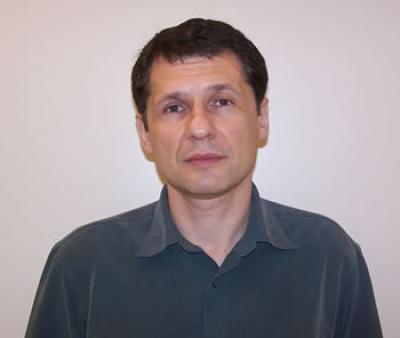Home > Press > UTSA/UT lead national nanoscience consortium
 |
| Nanoscale Interdisciplinary Research Team Principal Investigator Andrey Chabanov.
Credit: Kris Edward Rodriguez |
Abstract:
Researchers nationwide team up to achieve means of controlling optical energy at nanoscale levels
UTSA/UT lead national nanoscience consortium
San Antonio, TX | Posted on October 29th, 2007he University of Texas at San Antonio and The University of Texas at Austin are two of five research universities in a nationwide consortium awarded $1.4 million from the National Science Foundation. The Nanoscale Interdisciplinary Research Team (NIRT) grant is designed to explore ways of concentrating optical energy on a scale of nanometers and develop means of controlling optical energy for applications in nanoscience and nanotechnology.
NIRT Consortium member institutions include The University of Texas at San Antonio, The University of Texas at Austin, Harvard University, Cornell University and Case Western Reserve.
According to Andrey Chabanov, NIRT Principal Investigator and UTSA assistant professor of physics, the team was selected for the very competitive NSF grant on it's scientific merit and the potentially broad social impact of the proposed research.
"We want to attract college and high school students to participate in nanoscience research in our laboratories," said Chabanov. "As we continue to develop, we plan on sending several students from the San Antonio and Austin area to summer school programs in nanoscience at Harvard's research laboratories."
UTSA's nanoscience research focus involves fabrication and optical characterization of nanostructures for energy concentration in the infrared and visible spectral ranges. To conduct the research the grant will help purchase an atomic layer disposition system that will deposit materials by atomic layers. The equipment will allow for manipulation of materials at a nanoscale level.
Areas that could benefit from focusing small measures of light include the medical field where higher resolution imaging could be used on living tissues to detect diseases. The semiconductor industry could also benefit by making chips smaller through the use of light at a nanoscale level.
"The development of future imaging applications and nanophotonic devices is impeded by light diffraction which prevents confinement of light in the regions smaller than half of its wavelength," said Chabanov. "We have promising ideas how to circumvent the diffraction limit by utilizing polaritonic and plasmonic materials. This might enable super-resolution imaging, which can revolutionize label-free detection of biological and chemical substances.
Gennady Shvets, associate professor of physics at UT-Austin and grant co-PI, emphasized the interdisciplinary nature of the work in nanoplasmonics, a very new and promising area of science and technology requiring collaboration between scientists and engineers, specifically, synthetic chemists, material scientists, and experts in modeling, simulation and optics.
"Our group will be conducting experiments and theoretical modeling on a mid-infrared ‘superlens,' a novel device capable of resolving nanoscale features," said Shvets. "We hope that by the end of the project we can integrate the superlens with a nanofluidic delivery system and image various biological objects in their natural water environment."
In addition to introducing high school students to the world of nanoscience, the grant will also help support graduate and doctoral students enrolled in UTSA's joint master's and doctoral program with Southwest Research Institute. Since established in fall 2005, the doctoral program has 27 students enrolled, more than double its initial enrollment.
####
About University of Texas at San Antonio
The University of Texas at San Antonio is one of the fastest growing higher education institutions in Texas and the second largest of nine academic universities and six health institutions in the UT System. As a multicultural institution of access and excellence, UTSA aims to be a premier public research university providing access to educational excellence and preparing citizen leaders for the global environment.
UTSA serves more than 28,500 students in 63 bachelor’s, 43 master’s and 20 doctoral degree programs in the colleges of Architecture, Business, Education and Human Development, Engineering, Honors, Liberal and Fine Arts, Public Policy, Sciences and Graduate School. Founded in 1969, UTSA is an intellectual and creative resource center and a socioeconomic development catalyst for Texas and beyond.
For more information, please click here
Contacts:
Kris Edward Rodriguez
210-458-5116
Copyright © University of Texas at San Antonio
If you have a comment, please Contact us.Issuers of news releases, not 7th Wave, Inc. or Nanotechnology Now, are solely responsible for the accuracy of the content.
| Related News Press |
Academic/Education
![]() Rice University launches Rice Synthetic Biology Institute to improve lives January 12th, 2024
Rice University launches Rice Synthetic Biology Institute to improve lives January 12th, 2024
![]() Multi-institution, $4.6 million NSF grant to fund nanotechnology training September 9th, 2022
Multi-institution, $4.6 million NSF grant to fund nanotechnology training September 9th, 2022
Announcements
![]() NRL charters Navy’s quantum inertial navigation path to reduce drift April 5th, 2024
NRL charters Navy’s quantum inertial navigation path to reduce drift April 5th, 2024
![]() Discovery points path to flash-like memory for storing qubits: Rice find could hasten development of nonvolatile quantum memory April 5th, 2024
Discovery points path to flash-like memory for storing qubits: Rice find could hasten development of nonvolatile quantum memory April 5th, 2024
Alliances/Trade associations/Partnerships/Distributorships
![]() Chicago Quantum Exchange welcomes six new partners highlighting quantum technology solutions, from Chicago and beyond September 23rd, 2022
Chicago Quantum Exchange welcomes six new partners highlighting quantum technology solutions, from Chicago and beyond September 23rd, 2022
![]() University of Illinois Chicago joins Brookhaven Lab's Quantum Center June 10th, 2022
University of Illinois Chicago joins Brookhaven Lab's Quantum Center June 10th, 2022
|
|
||
|
|
||
| The latest news from around the world, FREE | ||
|
|
||
|
|
||
| Premium Products | ||
|
|
||
|
Only the news you want to read!
Learn More |
||
|
|
||
|
Full-service, expert consulting
Learn More |
||
|
|
||








